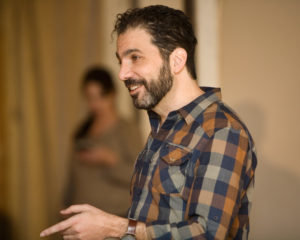By MARGIE O’LOUGHLIN
Long before University Ave. became a corridor of nonprofit organizations, the Metropolitan Regional Arts Council (MRAC) established itself at 2324 University Ave. in the Midway neighborhood.
Senior program director Greg Nielsen explained, “Our primary function is to be part of the state arts funding system. A state as geographically diverse as Minnesota would be difficult to serve with just a centralized state arts board in the urban core. The 11 regional arts councils can meet the needs of Minnesota’s 87 counties more responsively, reaching into the cultural nooks and crannies of our state.”
 Photo right: MRAC’s Greg Nielsen, senior program director, and Becky Franklin, grants and operations manager. The two are serving as interim co-directors until a permanent executive director can be named. (Photo by Margie O’Loughlin)
Photo right: MRAC’s Greg Nielsen, senior program director, and Becky Franklin, grants and operations manager. The two are serving as interim co-directors until a permanent executive director can be named. (Photo by Margie O’Loughlin)
According to the 2017 Creative Minnesota Report, Minnesota is home to “an astonishing 104,148 artists and creative workers who make their home in every county.” The term creative workers refers to 41 occupations including architects, curators, librarians, dancers, actors, choir directors, writers, editors and more—with an economic impact upwards of $600 million annually.
MRAC serves the highest density of artists state-wide: those living in the seven-county metro area, and will award some 500 grants to organizations and artists in fiscal year 2018.
“Regional arts councils are the entry points for many emerging, small, and mid-sized arts organizations and groups,” Nielsen said.
There are grants available through MRAC for arts activities support, organizational development, capital purchases, management consulting, and more. Most grants are publicly funded, with dollars received from the Minnesota State Arts Board.
The only privately funded grant is called the Next Step Fund, made available through a partnership with The McKnight Foundation. These $5,000 grants are awarded to individual artists for career advancement, and the application deadline is approaching fast on Mar. 19.
“In the spirit of MRAC being as accessible as possible,” Nielsen said, “work samples are not required for the Next Step Fund—and the application narrative is only two pages long. We’re often the first funder for recipients of this program. The untold story of MRAC is that we’re a community-directed organization. Our seven-person staff serves as the conduit of information, but we don’t choose who gets any of our grants.”
Grant selection for all of MRAC’s grants is determined by peer review panelists, who volunteer their time throughout the year. MRAC will use the services of more than 250 community volunteers in 2018. Each team of 4-10 will be assigned 25 applications to evaluate before making funding recommendations to MRAC’s board of directors. MRAC is currently accepting applications from new panelists who would bring a diverse personal, professional, and artistic perspective to the process. For more information, contact community connections manager Oskar Ly at Oscar@mrac.org.
 Photo right: Alan Berks, co-director of St. Paul’s Wonderlust Productions said, “For our current production, “Our House: The Capitol Play Project,” we received an Arts Activities Support grant from MRAC, and it has been invaluable. I’m not exaggerating when I say that our theater could not exist without the support of MRAC. Theirs was the very first grant we received when we did our Adoption Play Project last year. They made that play possible, and they have other community-driven grants that are essential to arts groups of our size.” (Photo by Margie O’Loughlin)
Photo right: Alan Berks, co-director of St. Paul’s Wonderlust Productions said, “For our current production, “Our House: The Capitol Play Project,” we received an Arts Activities Support grant from MRAC, and it has been invaluable. I’m not exaggerating when I say that our theater could not exist without the support of MRAC. Theirs was the very first grant we received when we did our Adoption Play Project last year. They made that play possible, and they have other community-driven grants that are essential to arts groups of our size.” (Photo by Margie O’Loughlin)
According to Nielsen, the state of the arts in Minnesota is very, very good. “We consistently rank #1 in the country for per capita dollars invested in the arts,” he said. “We owe our enviable status to the Legacy Amendment, which was voted in by Minnesota voters in 2008 and went into effect in 2010.
Six years ago, as a serious recession was brewing and opposition to tax increases was rising, Minnesota voters chose to write a 25-year tax increase into the state’s constitution. That decision raised the state’s sales tax by three-eighths of 1%, or half a penny for every dollar spent. Money from the Legacy Amendment, worth about $300 million per year, or $7.5 billion over its lifetime, is dedicated to clean water, the arts and culture, parks and trails, and outdoor habitat.
Nielsen concluded that “the Legacy Amendment has significantly broadened MRAC’s reach, but we’re still funding fewer than half of the worthy requests we receive. No artists are going to get rich off of these grants—they’re more like infusions—but they can definitely help artists get to the next level of their careers, and arts organizations to increase access to their communities.”
To learn more about the wide range of MRAC grant opportunities, contact the front desk staff at 651-645-0402.
Comments
No comments on this item Please log in to comment by clicking here